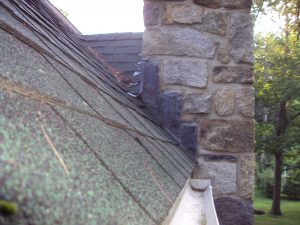A Flexible Chimney Liner can Breathe New Life into your Old Masonry Chimney
By Mark J. Donovan
|
|
Old chimneys can be a danger to your home and family. Old chimneys can have cracked tiles or crumbling masonry that can allow hot gases and dangerous fumes to enter into your home. Moreover, sparks from burning debris can potentially seep through the cracks and cause a fire in the home. If you have an old and dilapidated chimney you basically have three options.
Your first choice is to no longer use the chimney. In some cases this may be an impossible option if your main heating system requires it. Your second choice is to tear down the chimney and rebuild it. |
Tearing down an old chimney, however, is extremely expensive as it labor intensive due to the fact that it has to be torn down by hand. In addition, if the chimney is located in the center of the home major demolition and restoration is often involved to get access to the chimney.
Your final option, and often the best solution, is to reline the chimney with a flexible chimney liner. When it comes to flexible chimney liners there are two basic types, steel chimney liners and poured concrete chimney liners. Steel flexible chimney liners come in two basic types. There are heavy duty flexible liners made from stainless steel, and there are lightweight stainless steel liners. The lightweight stainless steel liners are most commonly used. There are also very lightweight aluminum chimney liners, however they are typically only used for gas appliance applications.
To install a metal or steel flexible chimney liner the chimney should first be checked for and cleared of any obstructions. A comprehensive chimney cleaning is not required since the steel liner will form the new chimney flue. Depending upon the particular situation the new steel chimney liner can be installed from the base or the top. If installed from the base, a winch is used to pull the flexible chimney liner up through the chimney as new sections are attached to it at the bottom. In other cases it may be pulled from the top down. Due to various chimney contours the liner may need to be slightly forced and massaged down or up through the chimney. Due to the fact that the chimney liner is flexible it can take the flexing and contouring without being damaged.
| After the steel flexible chimney liner has been positioned into place and permanently installed it should be insulated. Insulating the chimney helps by keeping the inside of the chimney flue warmer which in return helps with creating a sufficient updraft. Either ceramic wool blanket material or a vermiculite and concrete mixture can be used to insulate the flexible chimney liner.
The ceramic wool blanket insulation typically requires more space and as a result reduces the size of the chimney liner. If a ceramic wool blanket material is used to insulate the flexible chimney it needs to be wrapped around each section of chimney liner as it is installed into the old chimney. |
 |
In addition, a wire mesh has to be installed over the insulation blanket to enable the insulated chimney liner to be installed into the chimney. If insulating the chimney liner with the vermiculite and concrete mixture, it is simply poured down the original chimney flue and around the new flexible chimney liner to insulate it. As a result, the best way to insulate a new steel chimney liner is with the vermiculite and concrete mixture.
In general most flexible chimney liners are fabricated similarly. Some, however, have titanium added to the stainless steel to increase their resistance to high heat, and to add a little more strength. Depending upon the manufacturer they’re may be some slight variations in supporting clamps, clips, brackets, and screws that come with the chimney liner kit. Though a skilled do it yourself homeowner could potentially install a flexible chimney liner, in most cases it should be left to the pros. Not only is it hard work, it’s also important that it is installed right for the safety of your home and for proper operation.
For information on Restoring Baseboard Heating Element Covers, see the Restoring Baseboard Heating Element Covers eBook from HomeAdditionPlus.com. The Restoring Baseboard Heating Element Covers Ebook provides easy to understand, step-by-step instructions, on how to restore Baseboard Heating Element Covers so that they look new again. Pictures are included for every key step in the process.
For information on how to maximize a wood stove’s heating efficiency, see HomeAdditionPlus.com’s Installation of Hood over Wood Stove eBook.
Related Information
Additional Heating and Cooling Resources from Amazon.com
 |
 |
Free Heating and Cooling Price Quotes with No Obligation!
Fill out our 3-5 minute quick and easy form, and receive a free price quote on heating & cooling from one of our pre-screened and licensed HVAC contractors. This process is free and there is no obligation to continue once you receive your heating & cooling price estimate.

